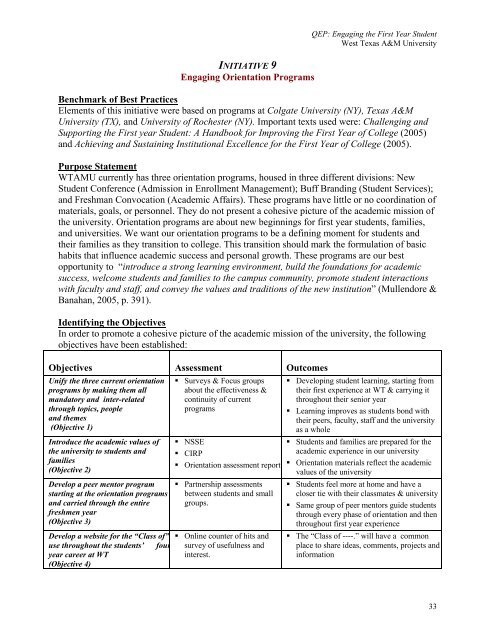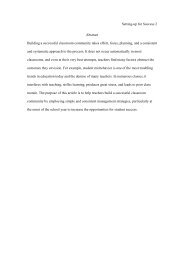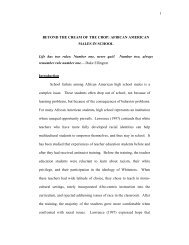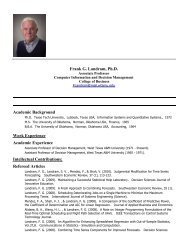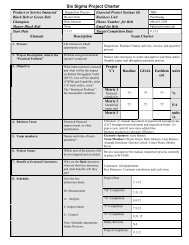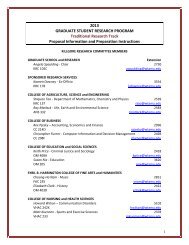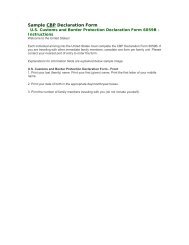(QEP) Engaging the First Year Student - West Texas A&M University
(QEP) Engaging the First Year Student - West Texas A&M University
(QEP) Engaging the First Year Student - West Texas A&M University
Create successful ePaper yourself
Turn your PDF publications into a flip-book with our unique Google optimized e-Paper software.
INITIATIVE 9<strong>Engaging</strong> Orientation Programs<strong>QEP</strong>: <strong>Engaging</strong> <strong>the</strong> <strong>First</strong> <strong>Year</strong> <strong>Student</strong><strong>West</strong> <strong>Texas</strong> A&M <strong>University</strong>Benchmark of Best PracticesElements of this initiative were based on programs at Colgate <strong>University</strong> (NY), <strong>Texas</strong> A&M<strong>University</strong> (TX), and <strong>University</strong> of Rochester (NY). Important texts used were: Challenging andSupporting <strong>the</strong> <strong>First</strong> year <strong>Student</strong>: A Handbook for Improving <strong>the</strong> <strong>First</strong> <strong>Year</strong> of College (2005)and Achieving and Sustaining Institutional Excellence for <strong>the</strong> <strong>First</strong> <strong>Year</strong> of College (2005).Purpose StatementWTAMU currently has three orientation programs, housed in three different divisions: New<strong>Student</strong> Conference (Admission in Enrollment Management); Buff Branding (<strong>Student</strong> Services);and Freshman Convocation (Academic Affairs). These programs have little or no coordination ofmaterials, goals, or personnel. They do not present a cohesive picture of <strong>the</strong> academic mission of<strong>the</strong> university. Orientation programs are about new beginnings for first year students, families,and universities. We want our orientation programs to be a defining moment for students and<strong>the</strong>ir families as <strong>the</strong>y transition to college. This transition should mark <strong>the</strong> formulation of basichabits that influence academic success and personal growth. These programs are our bestopportunity to “introduce a strong learning environment, build <strong>the</strong> foundations for academicsuccess, welcome students and families to <strong>the</strong> campus community, promote student interactionswith faculty and staff, and convey <strong>the</strong> values and traditions of <strong>the</strong> new institution” (Mullendore &Banahan, 2005, p. 391).Identifying <strong>the</strong> ObjectivesIn order to promote a cohesive picture of <strong>the</strong> academic mission of <strong>the</strong> university, <strong>the</strong> followingobjectives have been established:Objectives Assessment OutcomesUnify <strong>the</strong> three current orientationprograms by making <strong>the</strong>m allmandatory and inter-relatedthrough topics, peopleand <strong>the</strong>mes(Objective 1)Introduce <strong>the</strong> academic values of<strong>the</strong> university to students andfamilies(Objective 2)Develop a peer mentor programstarting at <strong>the</strong> orientation programsand carried through <strong>the</strong> entirefreshmen year(Objective 3)Develop a website for <strong>the</strong> “Class of”use throughout <strong>the</strong> students’ fouryear career at WT(Objective 4)• Surveys & Focus groupsabout <strong>the</strong> effectiveness &continuity of currentprograms• NSSE• CIRP• Orientation assessment report• Partnership assessmentsbetween students and smallgroups.• Online counter of hits andsurvey of usefulness andinterest.• Developing student learning, starting from<strong>the</strong>ir first experience at WT & carrying itthroughout <strong>the</strong>ir senior year• Learning improves as students bond with<strong>the</strong>ir peers, faculty, staff and <strong>the</strong> universityas a whole• <strong>Student</strong>s and families are prepared for <strong>the</strong>academic experience in our university• Orientation materials reflect <strong>the</strong> academicvalues of <strong>the</strong> university• <strong>Student</strong>s feel more at home and have acloser tie with <strong>the</strong>ir classmates & university• Same group of peer mentors guide studentsthrough every phase of orientation and <strong>the</strong>nthroughout first year experience• The “Class of ----.” will have a commonplace to share ideas, comments, projects andinformation33


